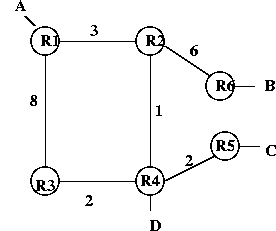Routing
Objectives
- Understand the basic types of routing algorithms.
- Know about the different possible routing metrics.
- Know how distance-vector routing algorithms work.
- Know how link-state routing algorithms work.
Inquiry
- How do you select the best path for a connection or datagram to take in a network?
- What are the measures that you might use to make routing decisions?
- What are the advantages and disadvantages of centralized and decentralized routing?
- What are the advantages and disadvantages of dynamic and static routing?
Preparation
Read section 4.2 in the book and the notes.
Knowledge, Comprehension and Problem Solving
Term
- Centralized routing
- Decentralized routing
- Distance-vector routing
- Dynamic routing
- Link-state routing
- Open Shortest Path First (OSPF) Protocol
- Route Information Protocol (RIP)
- Slow convergence
- Static routing
Questions
Given the following network:
- Show the initial distance-vector routing tables where all nodes know only about their neighbors.
- Show the routing tables after there is one exchange with all of their neighbors, and then when there is one more exchange.
- Show the adjacency matrix for a router if link-state routing is used.
- What happens at R3 if router R4 crashes?
- Give an example of slow convergence.
Analysis, Synthesis and Evaluation
- For the network show above, compare the network capacity used for distance-vector versus link-state routing. Assume that all distances are two-byte integers and that all addresses are four-byte integers. Also, assume that every router advertises its routes at 60 second intervals.
- Given a router with a router table, write the algorithm that it would use to route and switch and incoming packet.
